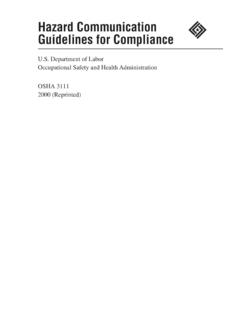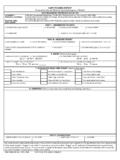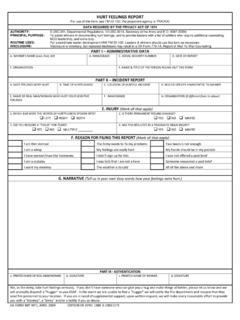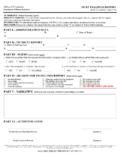Transcription of DEPARTMENT OF LABOR 29 CFR Part 1904
1 OSHA is making this document, the Final Rule for Occupational injury and Illness Recording and Reporting Requirements NAICS Update and Reporting Revisions, available for informational purposes only. This document has been submitted for publication in the Federal Register. Until the date of publication, the Final Rule can be found at After publication, the Final Rule can be accessed from or through the Federal Register website at _____. DEPARTMENT OF LABOR . Occupational Safety and Health Administration 29 CFR part 1904. [Docket No. OSHA-2010-0019]. RIN 1218-AC50. Occupational injury and Illness Recording and Reporting Requirements NAICS Update and Reporting Revisions AGENCY: Occupational Safety and Health Administration (OSHA), LABOR .
2 ACTION: Final rule. SUMMARY: OSHA is issuing a final rule to update Appendix A to Subpart B of its injury and Illness Recording and Reporting regulation. Appendix A contains a list of industries that are partially exempt from requirements to keep records of work-related injuries and illnesses due to relatively low occupational injury and illness rates. The updated appendix is based on more recent injury and illness data and lists industry groups classified by the North American Industry Classification System (NAICS). The current appendix lists industries classified by Standard Industrial Classification (SIC). 1. The final rule also revises the requirements for reporting work-related fatality, injury , and illness information to OSHA.
3 The current regulation requires employers to report work-related fatalities and in-patient hospitalizations of three or more employees within eight hours of the event. The final rule retains the requirement for employers to report work-related fatalities to OSHA within eight hours of the event but amends the regulation to require employers to report all work-related in-patient hospitalizations, as well as amputations and losses of an eye, to OSHA. within 24 hours of the event. DATES: The final rule becomes effective January 1, 2015. ADDRESSES: In accordance with 28 2112(a)(2), OSHA designates Ann Rosenthal, Acting Associate Solicitor of LABOR for Occupational Safety and Health, Office of the Solicitor, Room S-4004, DEPARTMENT of LABOR , 200 Constitution Avenue, NW.
4 , Washington, DC. 20210, to receive petitions for review of the final rule. FOR FURTHER INFORMATION CONTACT: For press inquiries: Frank Meilinger, OSHA, Office of Communications, Room N-3647, DEPARTMENT of LABOR , 200 Constitution Avenue, NW., Washington, DC 20210; telephone (202)-693-1999; email: For general and technical information: Miriam Schoenbaum, OSHA, Office of Statistical Analysis, Room N-3507, DEPARTMENT of LABOR , 200 Constitution Avenue, NW, Washington, DC 20210; telephone (202) 693-1841; email: SUPPLEMENTARY INFORMATION: 2. 1. Background A. Table of Contents The following table of contents identifies the major sections of the preamble to the final rule revising OSHA's Occupational injury and Illness Recording and Reporting Requirements regulation (NAICS update and reporting revisions): I.
5 Background A. Table of Contents B. References and Exhibits C. Introduction D. Regulatory History II. Legal Authority III. Section Partial Exemption for Certain Industries A. Background B. The Proposed Rule C. Comments on the Proposed Rule D. The Final Rule IV. Section Reporting Requirements for Fatalities, In-Patient Hospitalizations, Amputations, and Losses of an Eye A. Background B. The Proposed Rule C. Comments on the Proposed Rule D. The Final Rule V. Final Economic Analysis and Regulatory Flexibility Analysis A. Introduction B. Industrial Profile C. Costs of the Final Regulation D. Benefits E. Technological Feasibility F. Economic Feasibility and Impacts G. Regulatory Flexibility Certification H. Appendix VI. Environmental Impact Assessment VII.
6 Federalism VIII. Unfunded Mandates IX. Office of Management and Budget Review Under the Paperwork Reduction Act of 1995. X. State Plan Requirements XI. Consultation and Coordination with Indian Tribal Governments XII. List of Subjects XIII. Authority and Signature XIV. Final Rule 3. B. References and Exhibits In this preamble, OSHA references documents in Docket No. OSHA-2010-0019, the docket for this rulemaking. The docket is available at , the Federal eRulemaking Portal. References to documents in this rulemaking docket are given as Ex. followed by the document number. The document number is the last sequence of numbers in the Document ID. Number on For example, Ex. 1, the proposed rule, is Document ID. Number OSHA-2010-0019-0001.
7 The exhibits in the docket, including public comments, supporting materials, meeting transcripts, and other documents, are listed on All exhibits are listed in the docket index on However, some exhibits ( , copyrighted material) are not available to read or download from that Webpage. All materials in the docket are available for inspection and copying at the OSHA Docket Office, Room N-2625, DEPARTMENT of LABOR , 200 Constitution Avenue, NW, Washington, DC 20210; telephone (202). 693-2350. C. Introduction OSHA's regulation at 29 CFR 1904 requires employers with more than 10 employees in most industries to keep records of occupational injuries and illnesses at their establishments. Employers covered by these rules must record each recordable employee injury and illness on an OSHA Form 300, which is the Log of Work-Related Injuries and Illnesses , or equivalent.
8 Employers must also prepare a supplementary OSHA Form 301 injury and Illness Incident report or equivalent that provides additional details about each case recorded on the 300 Log. Finally, at the end of each year, employers are required to prepare a summary report of all 4. injuries and illnesses on the OSHA Form 300A, which is the Summary of Work-Related Injuries and Illnesses , and post the form in a visible location in the workplace. OSHA's current regulation at Section partially exempts establishments in certain lower-hazard industry groups from the requirement for keeping injury and illness records. Lower-hazard industries are currently those industries that are classified within SIC major industry groups 52-89 and that have an average Lost Workday injury and Illness (LWDII) rate at or below 75 percent of the three-year-average national LWDII rate for private industry.
9 The LWDII rate is an incidence rate that represents the number of non-fatal injuries and illnesses resulting in days away from work or job restriction per 100 full-time-equivalent employees per year. The LWDII data used to compile the current list of partially-exempt industry groups were taken from the Bureau of LABOR Statistics (BLS) Survey of Occupational Injuries and Illnesses (SOII) for the years 1996, 1997, and 1998. Establishments in the industry groups listed in Appendix A to Subpart B do not need to keep OSHA injury and illness records unless they are asked to do so in writing by OSHA, BLS, or a state agency operating under the authority of OSHA or BLS. Today's final rule replaces the list of partially-exempt industry groups in SIC 52-89, based on 1996-1998 injury /illness data, with a list of partially-exempt industry groups in NAICS.
10 44-81, based on 2007-2009 injury /illness data. Because overall injury and illness rates have been declining, the threshold Days Away, Restriction, or Transfer (DART) rate for partial exemption is (75% of the 2007-2009 average private industry DART rate of ), down from the previous (75% of the 1998 average private industry LWDII rate of ). Additionally, OSHA's current regulation at 29 CFR (a) requires employers to report all work-related fatalities and all in-patient hospitalizations of three or more employees to 5. OSHA within eight hours. Today's final rule leaves in place the current requirement that employers report all work-related fatalities to OSHA within eight hours. However, the final rule amends the current regulation by requiring employers to report all work-related in-patient hospitalizations that require care or treatment, all amputations, and all losses of an eye to OSHA.
















